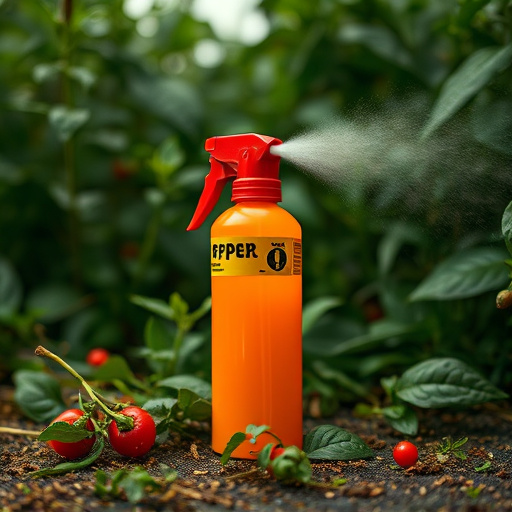Pepper spray's effectiveness across various climates makes it a versatile tool for law enforcement. While hot/humid environments speed up evaporation, cold conditions slow it down, impacting potency. Proper selection and maintenance, considering temperature, humidity, and wind, ensure optimal performance regardless of climate.
Law enforcement officers require versatile tools to maintain public safety across diverse, and sometimes extreme, climates. Among these, pepper spray stands out as a force for good in various weather conditions. This article delves into the effectiveness of pepper spray in different climates, exploring how specialized gear adapts to extreme temperatures while emphasizing optimal performance in varied environments. From bustling urban settings to remote regions, understanding the capabilities of pepper spray is crucial for effective law enforcement strategies.
- Pepper Spray: A Force for Safety in Different Climates
- Effectiveness of Pepper Spray in Various Weather Conditions
- Adapting to Extreme Temperatures with Pepper Spray Gear
- Climate-Specific Considerations for Law Enforcement Spray
- Optimal Performance: Pepper Spray in Diverse Environments
Pepper Spray: A Force for Safety in Different Climates
Pepper spray, a powerful tool used by law enforcement worldwide, offers a unique advantage in its versatility across various climates and environments. Its effectiveness is not limited to specific weather conditions, making it a force for safety in both hot and cold regions. In different climates, pepper spray serves as a reliable deterrent due to its ability to quickly incapacitate subjects without causing permanent harm.
In warmer, more humid climates, pepper spray remains potent and accurate, allowing officers to control situations swiftly. Conversely, colder temperatures do not diminish its performance; the spray’s chemical composition ensures it retains its effectiveness even in icy conditions. This versatility is crucial for law enforcement agencies operating in diverse geographical areas, ensuring their teams are equipped to handle any challenge that comes their way.
Effectiveness of Pepper Spray in Various Weather Conditions
Pepper spray, a common less-lethal tool used by law enforcement, has proven to be an effective deterrent and control measure in various situations. However, its effectiveness can be influenced by environmental factors, particularly weather conditions. In different climates, the performance and impact of pepper spray can vary significantly.
In dry, hot environments, pepper spray maintains its potency as it requires moisture to dissolve and reduce its strength. Conversely, humid or wet conditions can dilute the spray’s concentration, making it less effective. Snow and cold temperatures don’t typically affect its integrity, but wind and low humidity levels can cause the spray to dissipate faster, reducing its range and impact. Understanding these weather-related factors is crucial for law enforcement agencies to ensure optimal deployment of pepper spray equipment in diverse geographic locations.
Adapting to Extreme Temperatures with Pepper Spray Gear
In extreme temperatures, both hot and cold, law enforcement officers’ performance and safety can be significantly impacted by their equipment choices, including pepper spray. The effectiveness of pepper spray is not just about its potency; it’s also closely tied to environmental conditions. In colder climates, for instance, pepper spray can dry out the skin and eyes faster, potentially reducing its effectiveness against frozen or water-soaked surfaces. Conversely, in hotter environments, the spray might evaporate too quickly, making it less effective at close range where it’s needed most.
To adapt to these varying conditions, law enforcement agencies need gear that ensures pepper spray remains optimal across different climates. This includes considerations like using canisters designed for reduced evaporation rates in heat or those formulated to maintain their potency and stickiness in cold environments. Proper maintenance and storage methods are also crucial; keeping spare canisters in sealed bags or containers can help preserve them from excessive humidity or dryness, ensuring officers have reliable protection when they need it most.
Climate-Specific Considerations for Law Enforcement Spray
When equipping law enforcement officers with pepper spray, climate-specific considerations are essential for ensuring its effectiveness. Pepper spray’s performance can vary significantly in different weather conditions and environments. In colder climates, for instance, the chemical composition of pepper spray can become less potent due to reduced atmospheric pressure and lower temperatures. This may reduce its ability to disrupt an individual’s vision and breathing, impacting its overall effectiveness during winter operations.
Conversely, humid or hot environments pose their own challenges. High humidity levels can cause pepper spray to evaporate more rapidly, limiting its duration and impact on the target. Additionally, intense heat can cause the spray canisters to expand or even malfunction, leading to potential issues with deployment. Law enforcement agencies must consider these climate-related factors when selecting appropriate pepper spray equipment for their officers, ensuring it maintains optimal effectiveness across diverse geographical locations.
Optimal Performance: Pepper Spray in Diverse Environments
Pepper spray, a powerful tool for law enforcement, offers optimal performance when used appropriately in diverse environments. Its effectiveness varies across different climates and weather conditions, requiring officers to adapt their strategies accordingly. In colder regions, pepper spray can evaporate more slowly due to lower temperatures, potentially reducing its impact on suspects. Conversely, hot and humid environments may cause the spray to dissipate faster, making it less effective at close ranges.
To ensure maximum efficacy, officers should be trained in techniques suitable for various conditions. This includes learning how to account for wind direction, proximity to suspects, and environmental factors like humidity or snow. By understanding these variables, law enforcement can maintain control while minimizing the impact on bystanders and ensuring the safety of both officers and individuals they confront.
Pepper spray, a versatile tool for law enforcement, proves its effectiveness across diverse climates. Its performance is not just temperature-dependent but also significantly influenced by environmental factors like humidity and wind. By understanding these variables, officers can ensure optimal usage, enhancing safety in various weather conditions. Gear adaptations for extreme temperatures further solidify pepper spray’s role as a reliable force multiplier, ensuring its continued utility in any environment.
